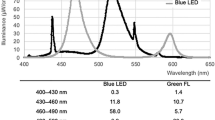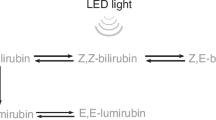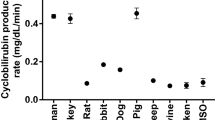Abstract
Background
Phototherapy (PT) is the standard treatment of neonatal unconjugated hyperbilirubinemia. Fluorescent tube (FT)-emitted PT light is known to induce oxidative DNA damage in neonates. Nowadays, however, FTs have largely been replaced by light-emitting diodes (LEDs) for delivering PT. Until now, it is unknown whether LED-PT causes oxidative DNA damage. We aim to determine whether LED-PT induces oxidative DNA damage in hyperbilirubinemic rats.
Methods
Adult Gunn rats, with genetically unconjugated hyperbilirubinemia, received LED-PT in the clinically relevant doses of 10 or 30 µW/cm2/nm. Urine was collected at 0, 24, and 48 h of PT. A group of young Gunn rats received intensive LED-PT of 100 µW/cm2/nm for 24 h. Urine was collected every 8 h and analyzed for the levels of oxidative DNA damage marker 8-hydroxy-2’deoxyguanosine (8-OHdG) and creatinine. DNA damage was evaluated by immunohistochemistry (γH2AX) of skin and spleen samples.
Results
LED-PT of 10 and 30 µW/cm2/nm did not affect urinary concentrations of 8-OHdG and creatinine or the 8-OHdG/creatinine ratio. Likewise, intensive LED-PT did not affect the 8-OHdG/creatinine ratio or the number of γH2AX-positive cells in the skin or spleen.
Conclusions
Our results show that LED-PT does not induce oxidative DNA damage in hyperbilirubinemic Gunn rats either at clinically relevant or intensive dosages.
Similar content being viewed by others
Log in or create a free account to read this content
Gain free access to this article, as well as selected content from this journal and more on nature.com
or
References
Dennery, P. A., Seidman, D. S. & Stevenson, D. K. Neonatal hyperbilirubinemia. N. Engl. J. Med. 344, 581–590 (2001).
Maisels, M. J. & McDonagh, A. F. Phototherapy for neonatal jaundice. N. Engl. J. Med. 358, 920–928 (2008).
Brown, A. K., Kim, M. H., Wu, P. Y. & Bryla, D. A. Efficacy of phototherapy in prevention and management of neonatal hyperbilirubinemia. Pediatrics 75, 393–400 (1985).
Arnold, C., Pedroza, C. & Tyson, J. E. Phototherapy in ELBW newborns: does it work? Is it safe? Evid. Random. Clin. Trials 38, 452–464 (2014).
Dahlquist, G. & Kallen, B. Indications that phototherapy is a risk factor for insulin-dependent diabetes. Diabetes Care 26, 247–248 (2003).
Maimburg, R. D., Olsen, J. & Sun, Y. Neonatal hyperbilirubinemia and the risk of febrile seizures and childhood epilepsy. Epilepsy Res. 124, 67–72 (2016).
Wickremasinghe, A. C., Kuzniewicz, M. W., Grimes, B. A., McCulloch, C. E. & Newman, T. B. Neonatal phototherapy and infantile cancer. Pediatrics https://doi.org/10.1542/peds.2015-1353 (2016).
Torres-Cuevas, I., Parra-Llorca, A. & Sánchez-Illana, A. Oxygen and oxidative stress in the perinatal period. Redox Biol. 12, 674–681 (2017).
Davis, J. M. & Auten, R. L. Maturation of the antioxidant system and the effects on preterm birth. Semin. Fetal Neonatal Med. 15, 191–195 (2010).
Stocker, R. Antioxidant activities of bile pigments. Antioxid. Redox Signal 6, 841–849 (2004).
Fujiwara, R., Nguyen, N., Chen, S. & Tukey, R. H. Developmental hyperbilirubinemia and CNS toxicity in mice humanized with the UDP glucuronosyltransferase 1 (UGT1) locus. Proc. Natl. Acad. Sci. USA 107, 5024–5029 (2010).
Bortolussi, G. et al. Age-dependent pattern of cerebellar susceptibility to bilirubin neurotoxicity in vivo in mice. Dis. Model Mech. 7, 1057–1068 (2014).
Barateiro, A. et al. Reduced myelination and increased glia reactivity resulting from severe neonatal hyperbilirubinemia. Mol. Pharmacol. 89, 84–93 (2016).
Rawat, V., Bortolussi, G., Gazzin, S., Tiribelli, C. & Muro, A. F. Bilirubin-induced oxidative stress leads to DNA damage in the cerebellum of hyperbilirubinemic neonatal mice and activates DNA double-strand break repair pathways in human cells. Oxid. Med. Cell. Longev. 1801243, 11 (2018).
Gathwala, G. & Sharma, S. Phototherapy induces oxidative stress in premature neonates. Indian J. Gastroenterol. 21, 153–154 (2002).
Tatli, M. M., Minnet, C., Kocyigit, A. & Karadag, A. Phototherapy increases DNA damage in lymphocytes of hyperbilirubinemic neonates. Mutat. Res. 654, 93–95 (2008).
Yahia, S. et al. Influence of hyperbilirubinemia and phototherapy on markers of genotoxicity and apoptosis in full-term infants. Eur. J. Pediatr. 174, 459–464 (2015).
Donneborg, M., Vandborg, P., Hansen, B., Rodrigo-Domingo, M. & Ebbesen, F. Double versus single intensive phototherapy with LEDs in treatment of neonatal hyperbilirubinemia. J. Perinatol. 38, 154 (2018).
Kawai, K., Li, Y. & Kasai, H. Accurate measurement of 8-OH-dG and 8-OH-Gua in mouse DNA, urine and serum: effects of X-ray irradiation. Genes Environ. 29, 107–114 (2007).
Horn, S., Barnard, S. & Rothkamm, K. Gamma-H2AX-based dose estimation for whole and partial body radiation exposure. PLoS ONE 6, e25113 (2011).
Wu, L. L., Chiou, C., Chang, P. & Wu, J. T. Urinary 8-OHdG: a marker of oxidative stress to DNA and a risk factor for cancer, atherosclerosis and diabetics. Clin. Chim. Acta 339, 1–9 (2004).
Kuo, L. J. & Yang, L. X. Gamma-H2AX - a novel biomarker for DNA double-strand breaks. In Vivo 22, 305–309 (2008).
Barolet, D. Light-emitting diodes (LEDs) in dermatology. Semin. Cutan. Med. Surg. 27, 227–238 (2008).
Maisels, M., Kring, E. & DeRidder, J. Randomized controlled trial of light-emitting diode phototherapy. J. Perinatol. 27, 565 (2007).
Kletkiewicz, H. et al. Effects of body temperature on post-anoxic oxidative stress from the perspective of postnatal physiological adaptive processes in rats. J. Physiol. Pharmacol. 67, 287–299 (2016).
Nuzum-Keim, A. & Sontheimer, R. Ultraviolet light output of compact fluorescent lamps: comparison to conventional incandescent and halogen residential lighting sources. Lupus 18, 556–560 (2009).
Safari, S., Eshraghi Dehkordy, S., Kazemi, M., Dehghan, H. & Mahaki, B. Ultraviolet radiation emissions and illuminance in different brands of compact fluorescent lamps. Int. J. Photoenergy 2015, 504674 (2015).
Moseley, H. & Ferguson, J. The risk to normal and photosensitive individuals from exposure to light from compact fluorescent lamps. Photodermatol. Photoimmunol. Photomed. 27, 131–137 (2011).
Vreman, H. J. et al. Light-emitting diodes: a novel light source for phototherapy. Pediatr. Res. 44, 804 (1998).
Demirel, G., Uras, N. & Celik, I. H. Comparison of total oxidant/antioxidant status in unconjugated hyperbilirubinemia of newborn before and after conventional and LED phototherapy: a prospective randomized controlled trial. Clin. Invest. Med. 33, 335–341 (2010).
Kale, Y., Aydemir, O. & Celik, Ü. Effects of phototherapy using different light sources on oxidant and antioxidant status of neonates with jaundice. Early Hum. Dev. 89, 957–960 (2013).
Erel, O. A new automated colorimetric method for measuring total oxidant status. Clin. Biochem 38, 1103–1111 (2005).
Uchida, Y. et al. Phototherapy with blue and green mixed-light is as effective against unconjugated jaundice as blue light and reduces oxidative stress in the Gunn rat model. Early Hum. Dev. 91, 381–385 (2015).
Wagner, K. H. et al. Looking to the horizon: the role of bilirubin in the development and prevention of age-related chronic diseases. Clin. Sci. (Lond.) 129, 1 (2015).
Bulmer, A. C., Blanchfield, J. T., Toth, I., Fassett, R. G. & Coombes, J. S. Improved resistance to serum oxidation in Gilbert’s syndrome: a mechanism for cardiovascular protection. Atherosclerosis 199, 390–396 (2008).
Brito, M. A., Brites, D. & Butterfield, D. A. A link between hyperbilirubinemia, oxidative stress and injury to neocortical synaptosomes. Brain Res. 1026, 33–43 (2004).
Kapitulnik, J. Bilirubin: an endogenous product of heme degradation with both cytotoxic and cytoprotective properties. Mol. Pharmacol. 66, 773–779 (2004).
Finkel, T. & Holbrook, N. J. Oxidants, oxidative stress and the biology of ageing. Nature 408, 239 (2000).
Odell, G. B., Natzschka, J. C. & Storey, G. Bilirubin nephropathy in the Gunn strain of rat. Am. J. Physiol. 212, 931–938 (1967).
Ebbesen, F., Hansen, T. W. & Maisels, M. J. Update on phototherapy in jaundiced neonates. Curr. Pediatr. Rev. 13, 176–180 (2017).
Acknowledgements
We thank Professor Henk Vreman for kindly providing the intensive LED phototherapy device.
Author information
Authors and Affiliations
Corresponding author
Ethics declarations
Competing interests
The authors declare no competing interests.
Additional information
Publisher’s note: Springer Nature remains neutral with regard to jurisdictional claims in published maps and institutional affiliations.
Supplementary information
Rights and permissions
About this article
Cite this article
van der Schoor, L.W.E., Hulzebos, C.V., van Faassen, M.H. et al. LED-phototherapy does not induce oxidative DNA damage in hyperbilirubinemic Gunn rats. Pediatr Res 85, 1041–1047 (2019). https://doi.org/10.1038/s41390-019-0367-y
Received:
Revised:
Accepted:
Published:
Issue date:
DOI: https://doi.org/10.1038/s41390-019-0367-y
This article is cited by
-
Bilirubin isomers during LED phototherapy of hyperbilirubinemic neonates, blue–green (~478 nm) vs blue
Pediatric Research (2024)
-
Action spectrum of phototherapy in hyperbilirubinemic neonates
Pediatric Research (2022)
-
Sixty years of phototherapy for neonatal jaundice: from serendipitous observation to standardized treatment and rescue for millions
Journal of Perinatology (2020)



